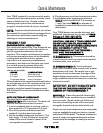
UNDERSTANDING THE
F.I.T. FORMULA
The workout portion of your exercise
program consists of three major variables:
Frequency, Intensity, and Time.
FFRREEQQUUEENNCCYY
:: HHooww OOfftteenn YYoouu EExxeerrcciissee
You should exercise three to five times a week
to improve your cardiovascular and muscle
fitness. Improvements are minimal with less
frequent exercise.
IINNTTEENNSSIITTYY::
HHooww HHaarrdd YYoouu EExxeerrcciissee
Intensity of exercise is reflected in your heart
rate. Exercise must be sufficiently rigorous to
strengthen your heart muscle and condition
your cardiovascular system. Only your
doctor can prescribe the target training heart
range appropriate for your particular needs
and physical condition.
• Start with exercise that stimulates you to
breathe more deeply.
• Alternate periods of moderate and easy
exercise to help your body adapt to new
levels of exertion without unnecessary
strain.
• If you are just beginning an exercise
program, you may be most comfortable
walking at a speed of 1-2 MPH. As you
use your treadmill regularly, higher speeds
may be more comfortable and more
effective.
• Inability to maintain a smooth, rhythmic
motion suggests that your speed and/or
elevation may be too great.
• If you feel out of breath before you have
exercised 12 minutes, you are probably
overdoing it.
As your fitness level improves, you will need
to increase your workload in order to reach
your target heart rate. The first increase may
be necessary after two to four weeks of
regular exercise. Never exceed your target
heart rate zone.
Increase the speed and/or incline on the
treadmill to raise your heart rate to the level
recommended by your doctor. The incline
feature can be used to greatly increase the
workload without increasing speed. The
chart below indicates how much the effort
changes with each percent of grade at
popular speeds for a person weighing 155
pounds.
MMEETTSS
One MET is the amount
of energy your body
uses when you’re
resting. If a physical
activity has an equivalent
of 6 METS, its energy
demands are 6 times
that of your resting state.
The MET is a useful
measurement, because it
accounts for differences
in body weight.
TTIIMMEE
:
HHooww LLoonngg YYoouu
EExxeerrcciissee
Sustained exercise conditions your heart,
lungs, and muscles. The longer you are able
to sustain exercise within your target heart
range, the greater the aerobic benefits.
• To begin, maintain two to three minutes of
steady, rhythmic exercise, then check your
heart rate.
• The initial goal for aerobic training is 12
continuous minutes.
• Increase your workout time approximately
one or two minutes per week until you are
able to maintain 20-30 continuous minutes
at your training heart rate.
UUSSIINNGG TTHHEE FF..II..TT.. FFOORRMMUULLAA
The F. I.T. formula and chart are designed to
help you begin a program tailored to your
needs. You may wish to keep an exercise log
to monitor your progress.
The F.I.T. Formula
2-24
MPH
Minutes
per mile
Grade %
0
1
2
3
4
5
6
7
8
9
10
11
12
13
14
15
16
2.0
30
METS
2.5
2.8
3.1
3.4
3.7
3.9
4.2
4.5
4.7
5.0
5.3
5.6
5.9
6.1
6.4
6.7
7.0
2.5
24
METS
2.9
3.3
3.6
3.9
4.3
4.7
5.0
5.3
5.7
6.0
6.4
6.7
7.1
7.4
7.7
8.1
8.4
3.0
20
METS
3.3
3.7
4.1
4.5
5.0
5.4
5.8
6.2
6.6
7.1
7.5
7.9
8.3
8.7
9.1
9.5
10.0
3.5
17
METS
3.7
4.2
4.7
5.1
5.6
6.1
6.6
7.1
7.6
8.0
8.5
9.0
9.5
10.0
10.5
10.9
11.4
4.0
15
METS
4.1
4.6
5.2
5.7
6.3
6.8
7.4
7.9
8.5
9.0
9.6
10.1
10.7
11.2
11.8
12.3
12.9


















